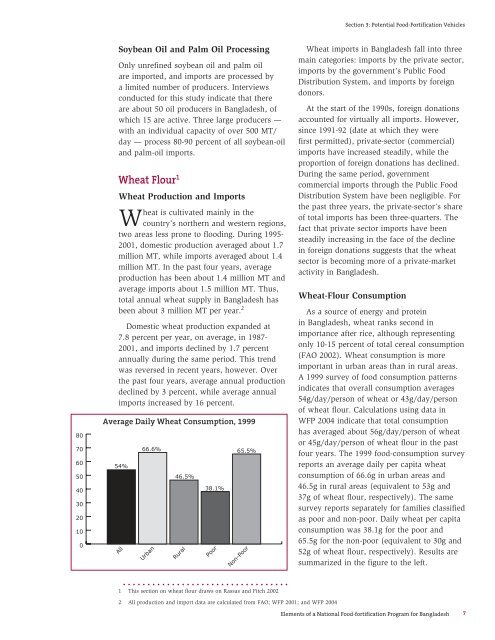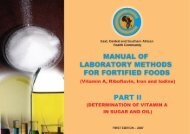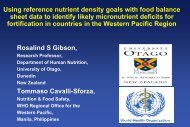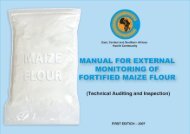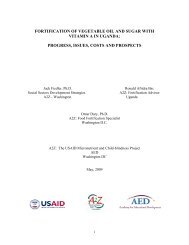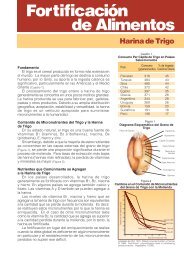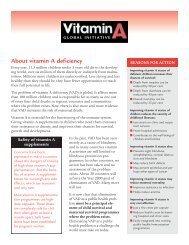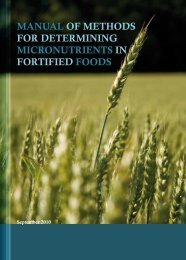Elements of a National Food- Fortification Program for Bangladesh
Elements of a National Food- Fortification Program for Bangladesh
Elements of a National Food- Fortification Program for Bangladesh
Create successful ePaper yourself
Turn your PDF publications into a flip-book with our unique Google optimized e-Paper software.
Section 3: Potential <strong>Food</strong>-<strong>Fortification</strong> Vehicles80706050403020100Soybean Oil and Palm Oil ProcessingOnly unrefined soybean oil and palm oilare imported, and imports are processed bya limited number <strong>of</strong> producers. Interviewsconducted <strong>for</strong> this study indicate that thereare about 50 oil producers in <strong>Bangladesh</strong>, <strong>of</strong>which 15 are active. Three large producers —with an individual capacity <strong>of</strong> over 500 MT/day — process 80-90 percent <strong>of</strong> all soybean-oiland palm-oil imports.Wheat Flour 1Wheat Production and ImportsWheat is cultivated mainly in thecountry’s northern and western regions,two areas less prone to flooding. During 1995-2001, domestic production averaged about 1.7million MT, while imports averaged about 1.4million MT. In the past four years, averageproduction has been about 1.4 million MT andaverage imports about 1.5 million MT. Thus,total annual wheat supply in <strong>Bangladesh</strong> hasbeen about 3 million MT per year. 2Domestic wheat production expanded at7.8 percent per year, on average, in 1987-2001, and imports declined by 1.7 percentannually during the same period. This trendwas reversed in recent years, however. Overthe past four years, average annual productiondeclined by 3 percent, while average annualimports increased by 16 percent.Average Daily Wheat Consumption, 199954%All66.6%Urban46.5%Rural38.1%Poor65.5%Non-PoorWheat imports in <strong>Bangladesh</strong> fall into threemain categories: imports by the private sector,imports by the government’s Public <strong>Food</strong>Distribution System, and imports by <strong>for</strong>eigndonors.At the start <strong>of</strong> the 1990s, <strong>for</strong>eign donationsaccounted <strong>for</strong> virtually all imports. However,since 1991-92 (date at which they werefirst permitted), private-sector (commercial)imports have increased steadily, while theproportion <strong>of</strong> <strong>for</strong>eign donations has declined.During the same period, governmentcommercial imports through the Public <strong>Food</strong>Distribution System have been negligible. Forthe past three years, the private-sector’s share<strong>of</strong> total imports has been three-quarters. Thefact that private sector imports have beensteadily increasing in the face <strong>of</strong> the declinein <strong>for</strong>eign donations suggests that the wheatsector is becoming more <strong>of</strong> a private-marketactivity in <strong>Bangladesh</strong>.Wheat-Flour ConsumptionAs a source <strong>of</strong> energy and proteinin <strong>Bangladesh</strong>, wheat ranks second inimportance after rice, although representingonly 10-15 percent <strong>of</strong> total cereal consumption(FAO 2002). Wheat consumption is moreimportant in urban areas than in rural areas.A 1999 survey <strong>of</strong> food consumption patternsindicates that overall consumption averages54g/day/person <strong>of</strong> wheat or 43g/day/person<strong>of</strong> wheat flour. Calculations using data inWFP 2004 indicate that total consumptionhas averaged about 56g/day/person <strong>of</strong> wheator 45g/day/person <strong>of</strong> wheat flour in the pastfour years. The 1999 food-consumption surveyreports an average daily per capita wheatconsumption <strong>of</strong> 66.6g in urban areas and46.5g in rural areas (equivalent to 53g and37g <strong>of</strong> wheat flour, respectively). The samesurvey reports separately <strong>for</strong> families classifiedas poor and non-poor. Daily wheat per capitaconsumption was 38.1g <strong>for</strong> the poor and65.5g <strong>for</strong> the non-poor (equivalent to 30g and52g <strong>of</strong> wheat flour, respectively). Results aresummarized in the figure to the left.1 This section on wheat flour draws on Rassas and Fitch 20022 All production and import data are calculated from FAO; WFP 2001; and WFP 2004<strong>Elements</strong> <strong>of</strong> a <strong>National</strong> <strong>Food</strong>-<strong>for</strong>tification <strong>Program</strong> <strong>for</strong> <strong>Bangladesh</strong>7


